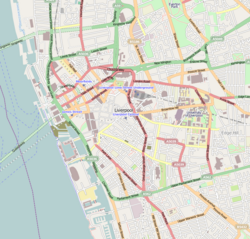Lord Street, Liverpool
 From Wikipedia - Reading time: 7 min
From Wikipedia - Reading time: 7 min
 Lord Street, Liverpool | |
| Location | Liverpool city centre |
|---|---|
| Postal code | L2 |
| Coordinates | 53°24′19″N 2°59′17.6″W / 53.40528°N 2.988222°W |
| Other | |
| Known for |
|
Lord Street is a street in central Liverpool, England that forms part of the city's main shopping district. The street is less than 300 metres in length. It joins Church Street to the east and James Street alongside Derby Square and the Queen Elizabeth II Law Courts to the west. The majority of land to the south of Lord Street is occupied by the Liverpool One complex, whilst the likes of Cavern Walks are located on the north side of the street.
In the last quarter of the eighteenth century, the street was known as Lord Molyneux Street and is described as "ill-built and very narrow" with "several good houses, inhabited by respectable families, some tolerably good shops, and several taverns".[1]: 123 At this time, the street was a loading point for waggons to Ormskirk and all parts of The Fylde.[1]: 176 Bates' Hotel was in existence by 1785 and a large room therein was used as a news-room for the reading of newspapers, prior to the opening of the Athenaeum News-Room and Library in 1798.[1]: 269 In 1851 while excavating for the gas company, workmen unearthed a stone arch and part of the abutment of a bridge on the corner of Lord Street and Whitechapel. The discovery confirmed an 18th century sighting at the time the foundations of the Bates' Hotel building were laid.[1]: 127–8 In 1799, residents and shopkeepers began laying flagstones along each side of the street for pavements; the middle of the street was laid with large, rough paving-stones — macadamization of the road surface came much later.[1]: 452
81–89 Lord Street is a Grade II listed office building from 1901, designed by architect Walter Aubrey Thomas.[2] It is of four storeys with attics and constructed of horizontal layers of orange and white stone. The listing comment says "the design recalls Siena Cathedral". Originally running through the centre of the building was a galleried shopping arcade under a glazed, domed roof. In 1935 the ground floor was redesigned for department store retailer British Home Stores.[3]
One of the early BBC radio relay stations, 6LV, broadcast from a studio above a cafe in Lord Street from 1924 to 1931. The building housing the studio suffered bomb damage in World War II.[4][5] After destruction by German aerial bombing much of Lord Street was rebuilt in the 1950s; the south side "drearily rebuilt" according to the Buildings of England series covering Liverpool.[6]
References
[edit]- ^ a b c d e Brooke, Richard (1853). Liverpool as it was during the last quarter of the Eighteenth Century, 1775 to 1800. Liverpool: Mawdsley.
- ^ Historic England, "81-89, Lord Street (1070625)", National Heritage List for England, retrieved 6 April 2024
- ^ Grimsditch, Lee; Hadfield, Charlotte (3 September 2023). "Lost shopping city arcade behind building thousands pass everyday". Liverpool Echo. Retrieved 6 April 2024.
- ^ Brocken, Michael (23 May 2016). Other Voices: Hidden Histories of Liverpool's Popular Music Scenes, 1930s-1970s. Routledge. p. 219. ISBN 978-1-317-08488-4.
- ^ BBC. "BBC Radio Merseyside celebrates 40 years of broadcasting". www.bbc.co.uk. Retrieved 6 April 2024.
- ^ Pollard, Richard; Pevsner, Nikolaus; Sharples, Joseph (1 January 2006). Lancashire: Liverpool and the Southwest. Yale University Press. p. 255. ISBN 978-0-300-10910-8.
 KSF
KSF